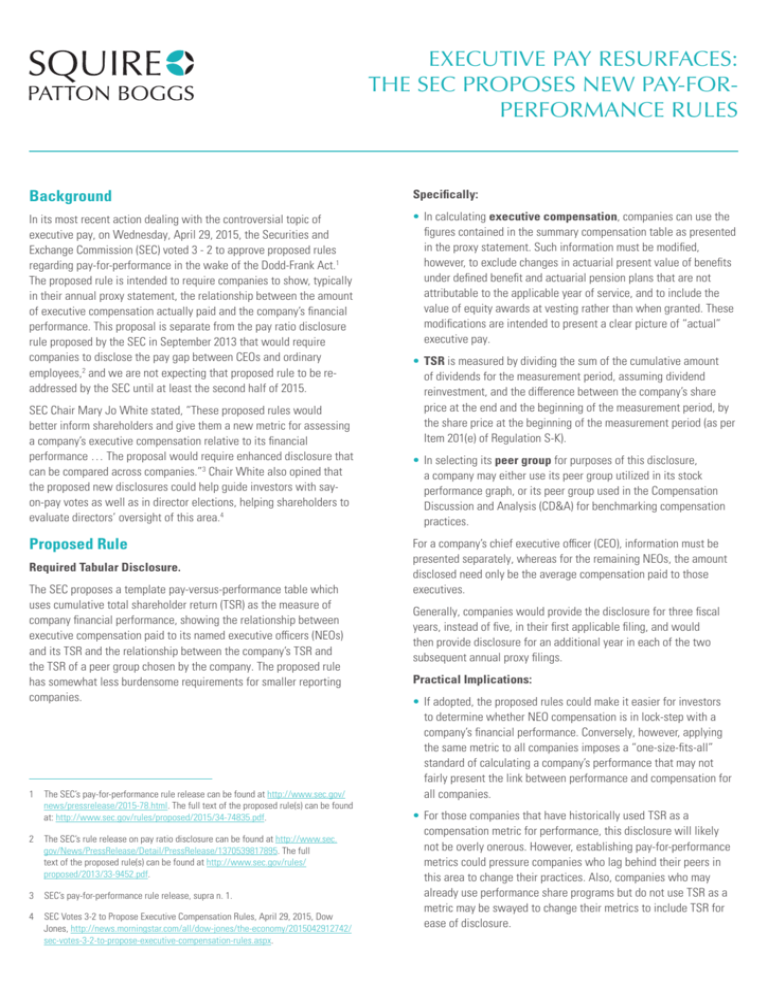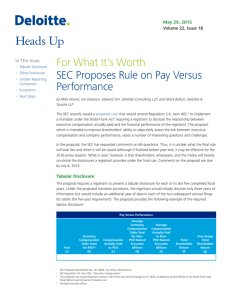
EXECUTIVE PAY RESURFACES:
THE SEC PROPOSES NEW PAY-FORPERFORMANCE RULES
Background
Specifically:
In its most recent action dealing with the controversial topic of
executive pay, on Wednesday, April 29, 2015, the Securities and
Exchange Commission (SEC) voted 3 - 2 to approve proposed rules
regarding pay-for-performance in the wake of the Dodd-Frank Act.1
The proposed rule is intended to require companies to show, typically
in their annual proxy statement, the relationship between the amount
of executive compensation actually paid and the company’s financial
performance. This proposal is separate from the pay ratio disclosure
rule proposed by the SEC in September 2013 that would require
companies to disclose the pay gap between CEOs and ordinary
employees,2 and we are not expecting that proposed rule to be readdressed by the SEC until at least the second half of 2015.
•In calculating executive compensation, companies can use the
figures contained in the summary compensation table as presented
in the proxy statement. Such information must be modified,
however, to exclude changes in actuarial present value of benefits
under defined benefit and actuarial pension plans that are not
attributable to the applicable year of service, and to include the
value of equity awards at vesting rather than when granted. These
modifications are intended to present a clear picture of “actual”
executive pay.
SEC Chair Mary Jo White stated, “These proposed rules would
better inform shareholders and give them a new metric for assessing
a company’s executive compensation relative to its financial
performance … The proposal would require enhanced disclosure that
can be compared across companies.”3 Chair White also opined that
the proposed new disclosures could help guide investors with sayon-pay votes as well as in director elections, helping shareholders to
evaluate directors’ oversight of this area.4
Proposed Rule
Required Tabular Disclosure.
The SEC proposes a template pay-versus-performance table which
uses cumulative total shareholder return (TSR) as the measure of
company financial performance, showing the relationship between
executive compensation paid to its named executive officers (NEOs)
and its TSR and the relationship between the company’s TSR and
the TSR of a peer group chosen by the company. The proposed rule
has somewhat less burdensome requirements for smaller reporting
companies.
1 The SEC’s pay-for-performance rule release can be found at http://www.sec.gov/
news/pressrelease/2015-78.html. The full text of the proposed rule(s) can be found
at: http://www.sec.gov/rules/proposed/2015/34-74835.pdf.
2 The SEC’s rule release on pay ratio disclosure can be found at http://www.sec.
gov/News/PressRelease/Detail/PressRelease/1370539817895. The full
text of the proposed rule(s) can be found at http://www.sec.gov/rules/
proposed/2013/33-9452.pdf.
3 SEC’s pay-for-performance rule release, supra n. 1.
4 SEC Votes 3-2 to Propose Executive Compensation Rules, April 29, 2015, Dow
Jones, http://news.morningstar.com/all/dow-jones/the-economy/2015042912742/
sec-votes-3-2-to-propose-executive-compensation-rules.aspx.
•TSR is measured by dividing the sum of the cumulative amount
of dividends for the measurement period, assuming dividend
reinvestment, and the difference between the company’s share
price at the end and the beginning of the measurement period, by
the share price at the beginning of the measurement period (as per
Item 201(e) of Regulation S-K).
•In selecting its peer group for purposes of this disclosure,
a company may either use its peer group utilized in its stock
performance graph, or its peer group used in the Compensation
Discussion and Analysis (CD&A) for benchmarking compensation
practices.
For a company’s chief executive officer (CEO), information must be
presented separately, whereas for the remaining NEOs, the amount
disclosed need only be the average compensation paid to those
executives.
Generally, companies would provide the disclosure for three fiscal
years, instead of five, in their first applicable filing, and would
then provide disclosure for an additional year in each of the two
subsequent annual proxy filings.
Practical Implications:
•If adopted, the proposed rules could make it easier for investors
to determine whether NEO compensation is in lock-step with a
company’s financial performance. Conversely, however, applying
the same metric to all companies imposes a “one-size-fits-all”
standard of calculating a company’s performance that may not
fairly present the link between performance and compensation for
all companies.
•For those companies that have historically used TSR as a
compensation metric for performance, this disclosure will likely
not be overly onerous. However, establishing pay-for-performance
metrics could pressure companies who lag behind their peers in
this area to change their practices. Also, companies who may
already use performance share programs but do not use TSR as a
metric may be swayed to change their metrics to include TSR for
ease of disclosure.
This new proposed mandate will likely add to the cost and time
of preparing disclosures, which should be taken into account.
In particular, companies that do not already utilize TSR as a
performance metric in relation to its compensation will want to
review its potential disclosure ramifications. All companies will want
to consider their peer group compositions and which group will be
best for this disclosure, and any appropriate adjustments to be made.
Further, companies should consider whether this disclosure should be
a part of their internal compensation discussions and decisions in the
future.
For additional information about the proposal, please contact your
principal Squire Patton Boggs lawyer or any of the lawyers listed in
this Alert.
Contacts
Daniel G. Berick
Americas Chair
+1 216 479 8374
daniel.berick@squirepb.com
Abby E. Brown
+1 202 457 5668
abby.brown@squirepb.com
Wendy K. LaDuca
+1 202 457 5686
wendy.laduca@squirepb.com
The contents of this update are not intended to serve as legal advice related to individual situations or as legal
opinions concerning such situations nor should they be considered a substitute for taking legal advice.
© Squire Patton Boggs.
squirepattonboggs.com
All Rights Reserved 2015
17328/05/15






